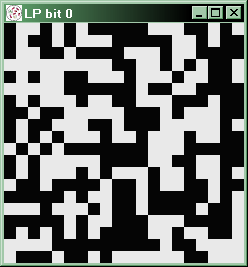FEARLUS Model 0-3 & 0-5 Environment
The environment includes the land parcels, land use, climate and economy. It consists of a rectangular grid of square cells of size (X, Y), each cell containing a single land parcel. Each land parcel has its own physical characteristics (represented by a bitstring of specified size). Similarly, the climate and economy are represented by bitstrings. The bitstrings of the land parcel physical characteristics are spatially heterogeneous, but temporally homogenous, whilst those of the climate and economy are spatially homogenous, but temporally heterogeneous. Land uses are also represented by bitstrings.
Land Parcels
The land parcels all have the same size of bitstring, which may consist of zero or more bits. The bitstrings may be clumped using a clumping cellular automaton, which is designed to make neighbouring land parcel bitstrings look as similar as possible. The CA is applied to each bit of the bitstring in turn, for a specified number of cycles. The rules of the CA are to change the value of a bit if three or more (Von Neumann toroidal) neighbours have a different value. The following demonstrates the effect of a single cycle of the CA on a land parcel bitstring:
| Land parcel bitstring at (x, y) | 0 | 1 | 1 | 0 | 0 |
| Bitstring of neighbour at (x - 1, y) | 1 | 0 | 0 | 0 | 1 |
| Bitstring of neighbour at (x + 1, y) | 1 | 1 | 0 | 1 | 0 |
| Bitstring of neighbour at (x, y - 1) | 0 | 1 | 0 | 0 | 1 |
| Bitstring of neighbour at (x, y + 1) | 0 | 1 | 0 | 1 | 1 |
| New bitstring at (x, y) | 0 | 1 | 0 | 0 | 1 |
A spatial view of the effect of the clumper on one of the bits in the land parcels' bit strings is given below. If you have JavaScript enabled, then move the mouse over the image to animate it, otherwise you can click on the image.

Climate and Economy
The climate and economy are both represented in the same way: with a bitstring and a set of toggle probabilities that specify, for each bit, the probability that it will change each year. So, if the probability of a particular bit is 0, then that bit will remain constant throughout the simulation. If 1, then it will switch between 0 and 1 each year. If the probability is 0.5, then the bit will take a random value each year. Because there is effectively no difference between them, they may be referred to together as "external conditions".
The climate and economy may have their bitstrings loaded from a file. The file simply contains a list of bitstrings that are loaded one after the other as they are needed each year. When the file runs out of bitstrings, the model will switch to toggling bits in the bitstrings as per the toggle probabilities.
Land Uses
The same, specified number of land uses are available for land managers to choose from during the simulation. Each land use consists of two bit strings (that do not change with time): a "match" bitstring and a "don't care" bitstring, that are used during the calculation of yield as follows:
| Land parcel physical characteristics bitstring (L) | Climate bitstring (C) | Economy bitstring (E) | |||||||||
| Concatenation of L, C and E (J) | 0 | 1 | 1 | 0 | 1 | 0 | 0 | 1 | 0 | 1 | 0 |
| Land use "match" bitstring (M) | 1 | 0 | 0 | 1 | 1 | 0 | 0 | 0 | 1 | 1 | 0 |
| Parity of J and M (P) | 0 | 0 | 0 | 0 | 1 | 1 | 1 | 0 | 0 | 1 | 1 |
| Land use "don't care" bitstring (D) | 0 | 0 | 1 | 0 | 0 | 0 | 0 | 0 | 0 | 1 | 0 |
| Bitwise OR of P and D (B) | 0 | 0 | 1 | 0 | 1 | 1 | 1 | 0 | 0 | 1 | 1 |
The yield is then a count of the number of bits that are set to 1 in B (6 in this case). The "match" and "don't care" bit strings represent the requirements of the land use in terms of physical characteristics, climate and economy to generate wealth for the land manager. Land managers therefore seek land uses with a good match with the physical characteristics of the land parcel, and the expected climate and economy, in order to make a profit.

